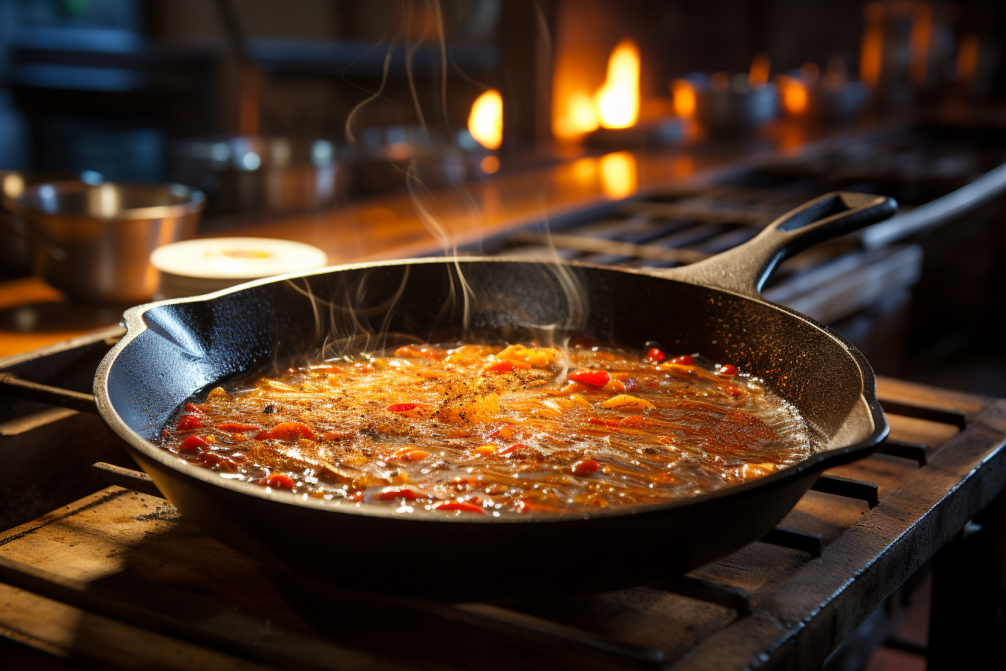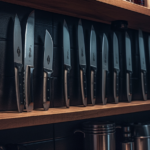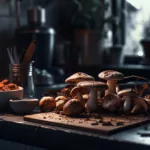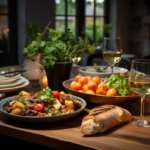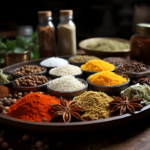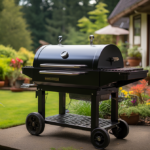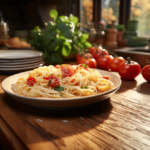Table of Contents
Mastering the Art of Cooking with Cast Iron Skillets
Welcome to Your Guide to Cooking Like a Pro Using Cast Iron Skillets! If there’s one cooking tool that deserves the spotlight, it’s definitely the trusty cast iron skillet. Not only do these bad boys deliver exceptional heat distribution, but they also add a delectable, unique flavor to your dishes that can’t be replicated by any other cookware.
Whether you’re a seasoned chef looking to up your game or a beginner who just snagged a hand-me-down skillet, this guide is here to help you unlock the full potential of this versatile kitchen essential. We’ll take you on a culinary journey, exploring the ins and outs of cooking with cast iron, and provide valuable tips and tricks to ensure your meals turn out perfectly every time.
Get ready to bid farewell to dry chicken and lackluster veggies! With a little know-how, you’ll be searing steaks to mouthwatering perfection, creating crispy golden crusts on cornbread, and achieving those coveted beautiful char marks on your grilled vegetables.
But that’s not all — we’ll also dive into proper seasoning, cleaning, and maintenance techniques. Forget any fears or misconceptions you may have heard about caring for these sturdy skillets. We’ll make it easy and hassle-free, so you can enjoy the benefits of cooking with cast iron for years to come.
So, grab your favorite skillet and let’s dive in! Get ready to elevate your cooking game and impress your friends and family with mouthwatering meals cooked to perfection using the mighty cast iron skillet.
The Benefits of Cooking with Cast Iron Skillets
If you’re wondering why everyone raves about cooking with cast iron skillets, let me fill you in on the incredible benefits they offer:
1. Excellent Heat Distribution: One of the biggest advantages of cast iron skillets is their ability to distribute heat evenly. This means your food will cook more consistently, reducing the risk of unevenly cooked dishes.
2. Non-Stick Surface: With proper seasoning and maintenance, cast iron skillets develop a natural non-stick surface that rivals the best non-stick pans on the market. This makes cooking and cleaning up a breeze!
3. Versatility: Cast iron skillets are incredibly versatile. You can use them on any stovetop (including induction), in the oven, or even over an open fire while camping. From frying, searing, and sautéing to baking, roasting, and broiling, these skillets can handle it all.
4. Retains Heat: Cast iron pans retain heat exceptionally well, keeping your food warm for longer periods. This makes them ideal for serving dishes straight from the stove or oven to the table.
5. Adds Flavor: The beauty of cooking with cast iron is the unique flavor it imparts to your food. Over time, the skillet develops a seasoned patina that enhances the taste of your dishes. You’ll get that mouthwatering, slightly smoky flavor that you simply can’t achieve with other cookware.
6. Durability: Cast iron skillets are built to last. With proper care, they can become a family heirloom, passed down from generation to generation. Unlike their non-stick counterparts, they won’t scratch or warp easily and can withstand high temperatures.
7. Health Benefits: Using cast iron skillets can also boost your iron intake. The iron from the pan can leach into your food, providing a small but beneficial dietary supplement.
Now that you’re well acquainted with the impressive benefits of cooking with cast iron skillets, it’s time to dive in and discover the endless possibilities they offer in the kitchen. Don’t be afraid to experiment, get creative, and most importantly, enjoy the delicious results these versatile pans can help you achieve!
Choosing the Right Cast Iron Skillet for Your Kitchen
Finding the perfect cast iron skillet can be a game changer in your cooking journey. Here are some essential aspects to consider when choosing the right one for your kitchen:
1. Size Matters: Cast iron skillets come in various sizes, so think about your cooking needs. If you’re cooking for a small household, a 10-inch skillet might be sufficient. However, if you frequently cook for larger groups or want to prepare dishes like whole roast chickens, a 12-inch skillet could be your best bet.
2. Weight Considerations: Keep in mind that cast iron skillets are heavy. While that weight is part of what makes them so durable, it’s important to consider your comfort level when maneuvering them. If you have weak wrists or difficulty lifting heavy objects, a smaller skillet might be more manageable for you.
3. Handle Style: Cast iron skillets usually come with either a long handle or a handle on each side. Consider your cooking style and storage space when deciding which handle style works best for you. Long handles are great for stove-to-oven transition, while skillets with dual handles make pouring and carrying easier.
4. Pre-Seasoned or Not: Some cast iron skillets are pre-seasoned, meaning they already have a non-stick coating. This is convenient if you’re new to cast iron cooking or don’t want to go through the seasoning process yourself. However, if you enjoy the traditional process of seasoning and developing your own patina, an unseasoned skillet allows you to start from scratch.
5. Quality and Brand Reputation: Look for reputable brands known for their quality cast iron products. Brands like Lodge, Finex, and Staub are trusted and offer a wide range of options to choose from. It’s worth investing in a well-made skillet that will last for years to come.
Keep these essential aspects in mind when browsing for your perfect cast iron skillet, and you’ll have a cooking companion that will serve you well in the kitchen. Remember, the key is choosing a skillet that suits your needs and preferences, so you can confidently embark on your culinary adventures like a pro!
No products found.
Seasoning Your Cast Iron Skillet for Optimal Performance
Seasoning your cast iron skillet is a crucial step in ensuring its optimal performance. It creates a natural non-stick surface and helps protect the skillet from rusting. Here are the essential steps to seasoning your cast iron skillet:
1. Wash and Dry: Start by washing your new cast iron skillet with hot water and a small amount of dish soap to remove any factory residue. Rinse it thoroughly and pat it dry with a clean towel.
2. Apply Oil: Using a paper towel or cloth, apply a thin layer of high-smoke-point oil to the entire skillet, including the handle. Good options for seasoning oil are vegetable oil, canola oil, or flaxseed oil. Make sure to coat both the interior and exterior surfaces evenly.
3. Remove Excess Oil: After applying the oil, use a clean paper towel or cloth to remove any excess oil. You want a thin, almost invisible layer of oil on the skillet. Too much oil can result in a sticky surface.
4. Bake: Place the skillet upside down on the middle rack of a preheated oven at around 400°F (200°C). Bake it for about an hour. Placing a baking tray or aluminum foil on the lower rack can catch any potential drips.
5. Cool and Repeat: Once the hour is up, turn off the oven and let the skillet cool completely inside. If you want a more robust seasoning, repeat this process a few times before using the skillet for cooking.
6. Maintaining the Seasoning: After each use, it’s important to clean the skillet without removing the seasoning. Avoid using harsh detergents or scrubbing with abrasive sponges. Instead, gently rinse with warm water, wipe clean, and dry thoroughly. Applying a thin layer of oil after each use helps maintain the seasoning.
By following these steps and regularly maintaining the seasoning of your cast iron skillet, you’ll ensure optimal performance and a reliable non-stick surface. Embrace the process, and your skillet will reward you with delicious, perfectly cooked meals every time you use it!
Proper Cleaning and Maintenance of Your Cast Iron Skillet
Taking care of your cast iron skillet is key to its longevity and performance. Here are the essential aspects of properly cleaning and maintaining your skillet:
1. Cleaning After Each Use:
- Allow the skillet to cool slightly before cleaning.
- Rinse the skillet with warm water to remove any food remnants. Avoid using soap as it can strip away the seasoning.
- If necessary, gently scrub with a soft brush or sponge to remove stuck-on bits.
- Dry the skillet thoroughly with a towel to prevent rusting.
2. Removing Stubborn Food Residue:
- For stubborn residue, you can use coarse salt or a paste made of equal parts coarse salt and cooking oil. Scrub the surface gently with a brush or sponge to remove the residue.
- Rinse and dry the skillet before proceeding with regular maintenance.
3. Seasoning Maintenance:
- After cleaning, apply a thin layer of oil to the skillet to maintain the seasoning. You can use a paper towel lightly coated with oil or a dedicated seasoning brush.
- Heating the skillet on the stovetop for a few minutes after oiling can help set the oil and maintain the non-stick surface.
4. Storing Your Skillet:
- Store your cast iron skillet in a cool, dry place to prevent moisture and humidity from causing rust.
- You can place a paper towel inside the skillet to absorb any moisture and prevent it from direct contact with the surface.
5. Dealing with Rust:
- If your skillet develops rust, scrub it with steel wool or a scrub brush to remove the rust. Rinse, dry thoroughly, and re-season the skillet before using it again.
By following these cleaning and maintenance practices, your cast iron skillet will remain in great shape and continue to provide excellent cooking performance for years to come. Proper care ensures that it becomes a cherished kitchen tool, delivering mouthwatering meals each time you use it. Embrace the regular maintenance routine, and you’ll be rewarded with a skillet that gets better with age.
No products found.
Preheating and Cooking Techniques for Outstanding Results
To achieve outstanding results when cooking with your cast iron skillet, it’s important to master the art of preheating and employ the right cooking techniques. Here are the essential aspects to consider:
1. Preheating:
- Place your skillet on the stove over medium heat and allow it to preheat for a few minutes. This ensures even heat distribution and prevents food from sticking.
- To test if your skillet is ready, flick a few droplets of water onto the surface. If they sizzle and evaporate almost immediately, it’s an indication that the skillet is properly preheated.
2. Oil and Fat:
- Before adding food to the skillet, add a small amount of oil or fat. Ensure the entire cooking surface is coated to prevent sticking and enhance the flavor profile.
- Good options for adding fat to your skillet include butter, vegetable oil, or bacon grease. Experiment with different fats to achieve different flavors.
3. Searing and Browning:
- For a beautiful sear or golden brown crust, make sure not to overcrowd the skillet. Overcrowding can lower the temperature and result in steaming rather than browning.
- Allow enough space between your food items to ensure each piece is in contact with the skillet’s surface.
4. Heat Control:
- Cast iron retains heat exceptionally well, so you might need to reduce the heat slightly during cooking to prevent scorching or burning.
- Maintaining a medium to medium-high heat is usually sufficient for most cooking tasks. Adjust the heat as needed to achieve desired results.
5. Avoid Acidic Ingredients:
- While cast iron skillets are versatile, it’s best to avoid cooking highly acidic foods for prolonged periods. Acidic ingredients can potentially strip away the seasoning and affect the flavor.
By mastering the preheating process and employing the right techniques, you’ll achieve outstanding results with your cast iron skillet. Whether you’re searing a steak, frying up crispy bacon, or creating a perfectly golden cornbread, the proper techniques will enhance the flavor and texture of your dishes. So, get ready to impress your taste buds and elevate your cooking game with these essential tips!
Mastering the Art of Searing Steaks in a Cast Iron Skillet
Cooking a perfectly seared steak is a skill that every home cook can master with the help of a trusty cast iron skillet. Follow these essential tips to achieve restaurant-quality results:
1. Choose the Right Cut and Thickness: Opt for a quality steak with good marbling for maximum flavor. Thickness is also important, as thicker cuts sear better without overcooking.
2. Let the Steak Come to Room Temperature: Remove the steak from the refrigerator and allow it to come to room temperature for about 30 minutes. This ensures even cooking and a more tender result.
3. Preheat the Skillet: Place your cast iron skillet over high heat and preheat it for a few minutes. You want the skillet to be smoking hot, which is necessary to achieve a good sear.
4. Pat the Steak Dry: Use paper towels to pat the steak dry before seasoning it. Moisture on the surface can interfere with the searing process.
5. Season Generously: Season the steak liberally with salt and freshly ground black pepper or your preferred steak seasoning. The high heat will help the seasoning penetrate the meat, enhancing its flavor.
6. Add Oil and Sear: Add a small amount of high-smoke-point oil, such as canola or grapeseed oil, to the preheated skillet. Carefully place the steak in the skillet and let it sear without disturbing it for a few minutes. Flip the steak and sear the other side.
7. Monitor the Internal Temperature: Use an instant-read meat thermometer to monitor the steak’s internal temperature. For medium-rare, aim for an internal temperature of around 130-135°F (55-57°C).
8. Rest and Enjoy: Once the steak reaches your desired level of doneness, transfer it to a cutting board and let it rest for a few minutes. This allows the juices to redistribute, resulting in a more flavorful and tender steak.
By following these steps and practicing your searing technique, you’ll be able to cook beautifully seared steaks that are juicy, flavorful, and perfectly cooked to your liking. Get ready to impress yourself and your guests with your newfound steak-searing prowess!
Creating Crispy and Delicious Cornbread in Your Skillet
Cornbread is a beloved classic that can be taken to a whole new level of deliciousness when cooked in a cast iron skillet. Follow these essential tips to achieve crispy and mouthwatering cornbread:
1. Preheat the Skillet: Place your cast iron skillet in the oven and preheat it to around 425°F (220°C). This will ensure that the cornbread bakes evenly and develops a crispy crust.
2. Mix the Batter: In a bowl, combine cornmeal, all-purpose flour, baking powder, salt, sugar (if desired), buttermilk, eggs, and melted butter. Mix until just combined – don’t overmix, as it can result in a tougher texture.
3. Add Fat to the Skillet: Once the skillet is preheated, carefully remove it from the oven and add a small amount of oil, bacon grease, or butter to the hot skillet. Swirl the fat around to coat the bottom and sides evenly.
4. Pour the Batter: Pour the cornbread batter into the hot skillet. It should sizzle as it hits the hot fat, creating a beautiful crust. Make sure the batter is evenly distributed in the skillet.
5. Bake to Perfection: Place the skillet back in the oven and bake the cornbread for about 20-25 minutes, or until a toothpick inserted into the center comes out clean. The top should be golden brown and crispy.
6. Rest and Serve: Once cooked, carefully remove the skillet from the oven and let the cornbread cool in the skillet for a few minutes. This will allow the flavors to settle and help the cornbread hold its shape. Cut into wedges or squares and serve warm.
7. Variations: To add some extra flavor and texture, consider customizing your cornbread by adding ingredients like cheese, jalapeños, diced onions, or corn kernels into the batter. Get creative and experiment with different combinations.
With these essential tips, you’ll be well on your way to creating a delectable cornbread that boasts a crispy exterior and a fluffy, moist interior. Your cast iron skillet will impart a unique flavor and texture that will make your cornbread truly outstanding. So, get baking and enjoy this classic southern staple in all its delicious glory!
Achieving Perfectly Roasted Vegetables with Charred Flavors
Roasting vegetables in a cast iron skillet is a fantastic way to bring out their natural flavors and achieve a delightful charred exterior. Here are the essential aspects to consider for perfectly roasted vegetables:
1. Preheat the Skillet: Preheat your cast iron skillet in the oven at around 425°F (220°C). This will help ensure even cooking and efficient browning.
2. Choose the Right Vegetables: Opt for vegetables that roast well and offer a nice texture. Some great options include potatoes, carrots, bell peppers, Brussels sprouts, cauliflower, and asparagus. Cut the vegetables into similar-sized pieces for even cooking.
3. Season to Perfection: Season the vegetables generously with salt, pepper, and your choice of herbs or spices. Toss them in a bowl with olive oil to ensure an even coating.
4. Arrange in the Skillet: Carefully remove the preheated skillet from the oven and add your seasoned vegetables in a single layer. Make sure the vegetables have enough space between them to prevent overcrowding, which can result in steaming rather than roasting.
5. Roast to Charred Perfection: Place the skillet back into the oven and roast the vegetables for 20-30 minutes, depending on the vegetable and desired level of doneness. Flip the vegetables halfway through the cooking process to ensure they brown evenly on both sides.
6. Check for Charred Goodness: Keep an eye on the vegetables as they roast. You want them to develop a nice char and caramelization, but be careful not to burn them. Adjust the oven temperature or cooking time accordingly.
7. Garnish and Serve: Once the vegetables are perfectly roasted and charred, remove the skillet from the oven and let them cool for a few minutes. Sprinkle with fresh herbs, a squeeze of lemon juice, or a sprinkle of parmesan cheese to enhance their flavors. Serve them as a delicious side dish or use them as a filling for wraps, salads, or pasta dishes.
With these essential tips, you’ll achieve perfectly roasted vegetables with charred flavors that bring out their natural sweetness and add an enticing smokiness. Embrace the versatility of your cast iron skillet and elevate your vegetable game to a whole new level of deliciousness. Enjoy the incredible flavors and textures that roasted vegetables can offer!
One-Pot Wonders: One-Dish Meals in Your Cast Iron Skillet
Your trusty cast iron skillet is not just for searing and sautéing; it’s also perfect for creating delicious one-dish meals that will satisfy your taste buds and simplify your cooking. Here are the essential aspects of cooking one-pot wonders in your cast iron skillet:
1. Versatile Ingredients: Choose ingredients that can cook together in the skillet, allowing their flavors to meld and create a hearty, satisfying meal. Some excellent options include chicken, sausage, vegetables, potatoes, rice, pasta, and beans.
2. Layering and Timing: Start by searing or browning your protein in the skillet, then set it aside. Next, add the vegetables, followed by ingredients like rice or pasta, and finally, reintroduce the protein. This layering technique ensures that everything cooks evenly and absorbs the delicious flavors.
3. Carefully Selecting Liquids: Choose the right liquids to accompany your one-dish meal. You might opt for broth, stock, wine, or even coconut milk for added richness and flavor. The liquid not only helps cook the ingredients but also creates a flavorful sauce.
4. Proper Heat Distribution: The excellent heat distribution of a cast iron skillet ensures that your one-dish meal is cooked evenly. This means you won’t end up with overcooked or undercooked portions. Maintain a steady heat level, adjusting as necessary to achieve the desired doneness.
5. Finishing Touches: Once your one-dish meal is cooked, consider adding finishing touches to take it to the next level. Toppings like fresh herbs, a squeeze of citrus juice, a sprinkle of cheese, or a drizzle of sauce can enhance the flavors and add visual appeal.
6. Serve Straight from the Skillet: The great thing about one-dish meals in a cast iron skillet is that they make for an impressive presentation. Serve your creation straight from the skillet, family-style, and let everyone dig in. Just be sure to use trivets or heat-resistant pads to protect your tabletop.
With these essential tips, the possibilities for one-dish meals in your cast iron skillet are endless. From comforting stews and flavorful paellas to sizzling stir-fries and delectable skillet lasagnas, you’ll be amazed at the variety and depth of flavors you can create in one pot. So, get cooking, and enjoy the simplicity and deliciousness of these one-pot wonders made in your trusty cast iron skillet!
Baking Sweet Treats with Cast Iron: Cakes, Pies, and More
Your cast iron skillet isn’t just for savory dishes; it’s also a versatile tool for baking delicious sweet treats. Here are the essential aspects of baking cakes, pies, and more in your cast iron skillet:
1. Properly Preparing the Skillet:
- Start by preheating your oven and placing your cast iron skillet inside to warm up. This will help ensure even baking and prevent sticking.
- Grease the skillet with butter or non-stick cooking spray to create a non-stick surface for your sweet treats.
2. Choosing the Right Recipe:
- Look for recipes specifically designed for cast iron skillets or ones that have been successfully adapted. These recipes take into account the skillet’s unique heat retention and distribution properties.
3. Size and Depth of the Skillet:
- Consider the size and depth of your skillet when choosing a recipe. The skillet should accommodate the batter or filling without overflowing during baking.
4. Versatility of Sweet Treats:
- Cast iron skillets are perfect for a range of sweet goodies. Try baking cakes, cobblers, pies, tarts, brownies, and even cookies in your skillet.
- Keep in mind that baking times may vary from traditional baking pans, so it’s essential to keep a close eye on your sweet treats as they bake.
5. Monitoring Baking Progress:
- Use a toothpick or cake tester to check for doneness. Insert it into the center of the treat—if it comes out clean or with a few crumbs, it’s likely ready.
- Be prepared to adjust baking times based on your individual oven and skillet, as they can vary.
6. Serving and Presentation:
- Once your sweet treat is baked to perfection, let it cool slightly in the skillet before serving. The cast iron skillet adds a rustic charm to your presentation.
- You can serve directly from the skillet or use a heat-resistant spatula to transfer the treat to a serving platter.
With these essential tips, you can create a delightful array of sweet treats in your cast iron skillet. Whether you’re baking a moist chocolate cake, a gooey fruit pie, or a buttery cobbler, the skillet’s even heat distribution will contribute to beautifully baked, golden goodies that are sure to impress. So, grab your skillet and let your sweet baking adventures begin!
Outdoor Cooking and Grilling with Cast Iron Skillets
One of the beauties of cast iron skillets is their versatility, and they can be used not only on stovetops but also for outdoor cooking and grilling. Here are the essential aspects of cooking with cast iron skillets in the great outdoors:
1. Campfires and Fire Pits:
- Cast iron skillets are perfect for cooking over campfires or fire pits. The sturdy construction and excellent heat retention make them ideal for outdoor cooking adventures.
- Secure the skillet over the flames using grill grates or balanced over a bed of hot charcoal.
2. Preheating the Skillet:
- Just like indoor cooking, it’s essential to preheat your skillet before using it on an outdoor grill or fire. Allow the skillet to heat up gradually over the heat source.
3. Grilling with Your Skillet:
- Place the skillet directly on the grill grates or over the fire for an incredible grilling experience. The skillet acts as a versatile cooking surface for a variety of dishes.
4. Grilling Vegetables and Seafood:
- Slice up your favorite vegetables, toss them in some oil and seasoning, and grill them in the skillet for deliciously charred and smoky flavors.
- You can also use the skillet to cook delicate seafood like shrimp, scallops, or fish fillets. The skillet prevents delicate items from falling through grill grates.
5. One-Pan Outdoor Meals:
- The versatility of a cast iron skillet allows you to cook outdoor one-pot wonders. Prepare hearty meals like campfire chili, skillet cornbread, or even hearty breakfasts with eggs, bacon, and potatoes, all in one skillet.
6. Care and Cleaning:
- After cooking outdoors, clean the skillet by scrubbing it with hot water and a stiff brush. Dry it thoroughly and then apply a thin layer of oil to protect it from moisture and prevent rusting.
Whether you’re enjoying a camping trip, a backyard barbecue, or a picnic in the park, don’t forget to bring your trusty cast iron skillet along. It will help you create delicious, flavorful meals with that coveted outdoor cooking charm. Embrace the versatility of your skillet and let the possibilities of outdoor cooking with cast iron expand your culinary horizons!
Beyond the Basics: Specialty Dishes to Try in Your Skillet
While cast iron skillets are perfect for staple dishes like seared steaks and roasted vegetables, they also excel at cooking specialty dishes with superb results. Step up your culinary game and try these specialty dishes in your cast iron skillet:
1. Frittatas and Quiches:
- Whip up a fluffy frittata or a savory quiche in your skillet. Start by sautéing vegetables and proteins, then pour in the beaten eggs and bake until set. This versatile dish is perfect for breakfast, brunch, or a light dinner.
2. Deep-Dish Pizza:
- Embrace your inner pizzaiolo and create a mouthwatering deep-dish pizza in your skillet. Layer the dough in the skillet, add your favorite toppings, and let it bake to cheesy perfection in the oven. The skillet imparts a golden, crispy crust.
3. Skillet Desserts:
- Go beyond the usual cakes and pies and explore a world of delectable skillet desserts. Try baking gooey skillet cookies, sizzling fruit cobblers, or decadent chocolate lava cakes. The skillet’s heat retention promotes even baking and gorgeous caramelization.
4. Paella or Risotto:
- Turn your skillet into a culinary tour de force by preparing a flavorful paella or creamy risotto. Sauté the aromatics and proteins, add the rice and liquid, then let everything simmer to perfection. The skillet’s excellent heat distribution ensures a perfect, evenly cooked dish.
5. Gourmet Grilled Cheese:
- Take a classic grilled cheese sandwich to the next level by making it in your cast iron skillet. Spread butter on the outside of the bread, then assemble with your preferred cheeses and any additional fillings. Grill the sandwich in the skillet until golden and melty. The skillet creates a crispy exterior, while the cheese melts into gooey perfection.
These specialty dishes allow you to flex your culinary creativity and showcase the versatility of your cast iron skillet. Don’t be afraid to experiment and adapt recipes to suit your taste. With the right technique and a bit of imagination, your skillet will become your go-to tool for mastering a wide range of specialty dishes like a true culinary pro!
Troubleshooting Common Issues and How to Fix Them
While cooking with cast iron skillets is overall a straightforward process, some common issues may arise. Here are a few troubleshooting tips to help you overcome those challenges and continue cooking like a pro:
1. Sticky Food or Uneven Browning:
- Issue: Food sticking to the skillet or browning unevenly can occur due to insufficient preheating or inadequate oil.
- Solution: Ensure that you preheat the skillet thoroughly before adding any ingredients. Let it heat up gradually to avoid hot spots. Also, make sure to use enough oil or fat to create a non-stick surface.
2. Rusty Skillet:
- Issue: If you notice rust on your cast iron skillet, it’s crucial to address it promptly to prevent further damage.
- Solution: Scrub the rusted area with steel wool or a scrub brush to remove the rust. Rinse with hot water, dry completely, and reseason the skillet before using it again. Regular seasoning and proper drying after each use can help prevent rust.
3. Stained or Discolored Skillet:
- Issue: Over time, your cast iron skillet may develop stains or discoloration.
- Solution: Scrub the skillet with a paste made of equal parts baking soda and water to help remove stains. If necessary, you can also use a small amount of mild dish soap. Rinse thoroughly, dry completely, and reseason the skillet to restore its appearance.
4. Food Tastes Metallic:
- Issue: If your cooked food has a metallic taste, it could indicate that your skillet needs seasoning or that acidic ingredients have stripped the seasoning layer.
- Solution: Re-season the skillet by applying a few thin coats of oil and baking it in the oven. Avoid cooking highly acidic foods in the skillet or limit their contact time to prevent stripping the seasoning.
By addressing these common issues, you can maintain and restore the performance of your cast iron skillet. Don’t get discouraged if you encounter any challenges along the way—troubleshooting and overcoming them will only enhance your cooking skills. Practice, patience, and proper care will ensure that your cast iron skillet remains a reliable and cherished kitchen companion for years to come.
Dos and Don’ts of Cooking with Cast Iron Skillets
To help you make the most of your cast iron skillet and ensure successful cooking every time, here are some essential dos and don’ts to keep in mind:
Dos:
- Do Preheat Your Skillet: Always preheat your cast iron skillet before adding ingredients. This ensures even cooking and prevents sticking.
- Do Season Your Skillet: Properly season your skillet to create a non-stick surface. Regular seasoning helps maintain its performance and enhances the flavor of your dishes.
- Do Use the Right Utensils: When cooking in a cast iron skillet, use utensils made of silicone, wood, or other non-metal materials to avoid scratching the surface.
- Do Clean and Dry Thoroughly: After each use, clean your skillet with hot water and a brush or sponge. Dry it thoroughly with a towel to prevent rusting.
- Do Re-season when Needed: If your skillet starts losing its non-stick quality or shows signs of rust, re-season it by applying a thin layer of oil and baking it in the oven.
Don’ts:
- Don’t Use Harsh Cleaners or Dishwashers: Avoid using harsh detergents, abrasive scrubbers, or placing your cast iron skillet in the dishwasher. These can strip away the seasoning.
- Don’t Soak your Skillet: Avoid soaking your skillet in water for extended periods. Instead, clean it promptly after use to prevent moisture from causing rust.
- Don’t Use High Heat Continuously: While cast iron skillets can handle high heat, it’s best to avoid continuous high-temperature cooking, as it can damage the skillet and reduce the longevity of the seasoning.
- Don’t Store Food in the Skillet: After cooking, transfer your food to separate containers for storage. Leaving food in the skillet can lead to a metallic taste and may affect the seasoning.
- Don’t Skip Maintenance: Regularly maintain your cast iron skillet by seasoning, cleaning, and storing it properly. Consistent care will keep it in excellent condition and ensure optimal cooking performance.
By following these dos and don’ts, you’ll be well on your way to cooking like a pro with your cast iron skillet. Embrace the versatility and timeless appeal of this kitchen essential, and let it elevate your culinary creations to new heights!
Exploring Different Types and Styles of Cast Iron Cookware
Cast iron cookware comes in various types and styles, each with its own unique features and benefits. Here are the essential aspects to consider when exploring different types and styles of cast iron cookware:
1. Skillets:
- Skillets, also known as frying pans, are the most common and versatile type of cast iron cookware. They feature sloped sides, making them ideal for sautéing, frying, searing, and baking.
2. Dutch Ovens:
- Dutch ovens are large, deep pots with tight-fitting lids. They excel at slow-cooking, braising, and oven roasting. Their heavy construction promotes even heat distribution, making them perfect for stews, soups, and pot roasts.
3. Grill Pans:
- Grill pans feature raised ridges that emulate the grill grates, allowing you to achieve grill marks and charred flavors indoors. They’re great for grilling steaks, vegetables, and even sandwiches.
4. Griddles:
- Griddles have a smooth, flat surface that’s perfect for cooking pancakes, quesadillas, and other flatbreads. They provide ample space for cooking multiple items at once.
5. Baking Pans:
- Baking pans, such as cornbread pans and muffin pans, are specialized cast iron cookware designed for baking specific items. They offer enhanced heat conductivity, resulting in evenly baked goods.
6. Specialty Cookware:
- Cast iron cookware also includes specialty items like woks, chicken fryers, mini skillets, and more. These pieces cater to specific cooking needs and allow for diverse culinary creations.
When choosing your cast iron cookware, consider the style that best suits your cooking preferences and needs. Skillets and Dutch ovens are must-haves due to their versatility, while specialized pieces can add convenience and variety to your cooking routine.
Whichever types and styles of cast iron cookware you choose, it’s important to consider quality brands known for their craftsmanship and durability. Investing in well-made cast iron cookware will ensure a reliable kitchen companion that can be passed down through generations.
So, explore the world of cast iron cookware, embrace the possibilities it offers, and elevate your cooking like a true pro!
Kitchen Hacks and Pro Tips for Cooking with Cast Iron
Cooking with cast iron skillets can be a true joy, and with a few kitchen hacks and pro tips, you can take your skills to the next level. Here are some essential tips to enhance your cast iron cooking experience:
1. Preheat Your Skillet:
- Always preheat your cast iron skillet before adding ingredients. This ensures even heat distribution and helps prevent sticking.
2. Use Oil with a High Smoke Point:
- When seasoning or cooking with your skillet, choose oils with high smoke points, such as vegetable oil, canola oil, or grapeseed oil. These oils can withstand high temperatures without breaking down and imparting off flavors.
3. Gradually Increase Heat:
- When using high heat for searing or browning, start with medium heat and gradually increase it. This allows the skillet to heat evenly and prevents burning or scorching.
4. Utilize Heat Retention:
- Take advantage of the excellent heat retention of cast iron by turning off the heat a few minutes before food is fully cooked. The residual heat will continue cooking the dish without overcooking it.
5. Avoid Cold Ingredients:
- Ensure that ingredients added to your hot skillet are at room temperature. Adding cold ingredients directly to a hot skillet can cause the temperature to drop and result in uneven cooking.
6. Experiment with Different Seasons:
- Don’t limit yourself to the standard salt and pepper. Explore different seasonings, herbs, and spices to enhance the flavor of your dishes. Get creative and try combinations that suit your taste preferences.
7. Proper Cleaning and Maintenance:
- After cooking, clean your cast iron skillet with hot water, a brush or sponge, and minimal soap, if needed. Dry it thoroughly with a towel to prevent rusting, and apply a thin layer of oil to maintain the seasoning.
These kitchen hacks and pro tips will help you make the most of your cast iron skillet and effortlessly cook like a pro. Embrace the versatility and timeless appeal of this kitchen essential, and enjoy the delicious results it brings to your table. So, get cooking and let your cast iron skillet be your trusty sidekick in creating memorable meals!
Conclusion
In conclusion, your trusty cast iron skillet is like having a secret weapon in your kitchen. By following the tips and techniques outlined in this guide, you can unlock the full potential of your skillet and cook like a pro. From perfectly seared steaks to crispy roasted vegetables, and from delectable one-dish wonders to mouthwatering sweet treats, your cast iron skillet can do it all.
Remember to preheat your skillet, choose the right oils, and season it properly to create that coveted non-stick surface. Explore different types of dishes, from frittatas to deep-dish pizzas, and take advantage of the skillet’s versatility to elevate your culinary game.
But it doesn’t stop there. Proper cleaning, maintenance, and troubleshooting are also essential to keep your cast iron skillet in top shape. With a little care and attention, your skillet can become a cherished heirloom that lasts for generations.
So, grab your cast iron skillet, unleash your creativity, and let it become your go-to tool for creating delicious and impressive meals. With the right techniques, a sprinkle of seasoning, and a dash of passion, you’ll be cooking like a pro in no time. Prepare to wow your friends and family with mouthwatering dishes that showcase the timeless charm and exceptional performance of your beloved cast iron skillet. Happy cooking!

